Andean Explorer and Amazon Adventure 3
Videos in this blog
 ![]()  Return to Cusco and Corpus Christi Festival Parade
 Return to Cusco and Corpus Christi Festival Parade
Blog Post 3
May 20 to 22, 2016
Trekking The Inca Trail, climbing Montana Machu Picchu, and exploring Machu Picchu
Friday, May 20: Day 6
The Inca Trail
We were up before 5 AM, had breakfast, and sleepily piled into the van for the hour-long trip from Urubamba back to Ollantaytambo where we boarded the train to Machu Piccu. We would be dropped off at Km 104, in the middle of nowhere, at the trail head of the last day trek to Machu Picchu.
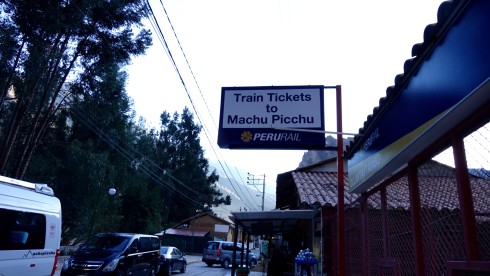
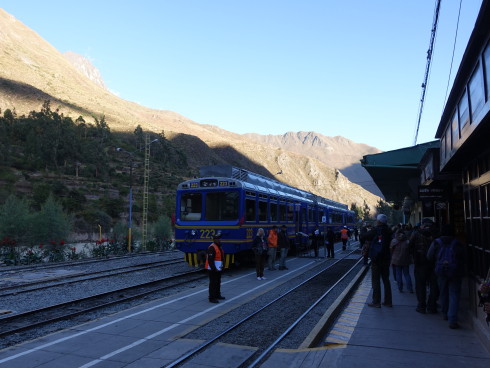
Boarding the train for Kilometer 104, the Inca Trail trail head.                                                  Photo Credit: Dick Alkire
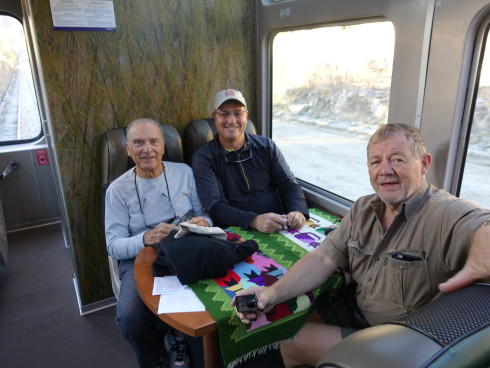
Dick, Dave and Willie on the Machu Picchu train.                                                                               Photo Credit Bill Riat
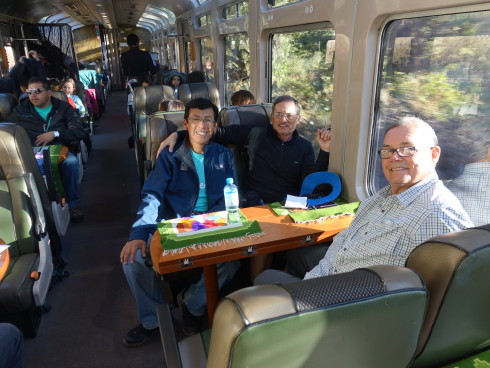
Our guide, Thomas, Jim Macklin, and Jim Simon the train to Machu Picchu.                                  Photo Credit: Bill Riat
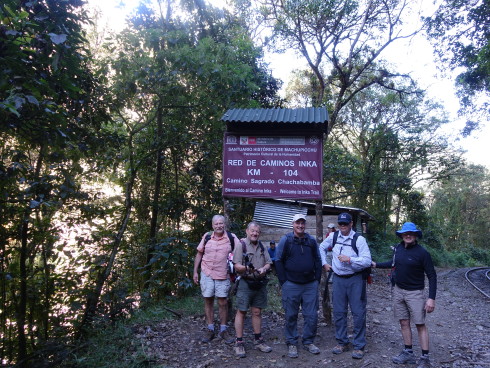
Km 104 – drop-off for the Inca Trail trail head.                         Photo Credit: Our guide, Thomas with Bill’s Sony Camera
We all made the 5ft drop from the train ladder to the ground below, except Jim Simon whose backpack launched a ferocious attack as he left the train. Only a minor injury, however!
We started over the bridge spanning the river and started what turned out to be a very challenging 8-hour trek, with many elevation changes, steep, uneven stairs cut out of the rock or built by Inca hundreds of years ago.
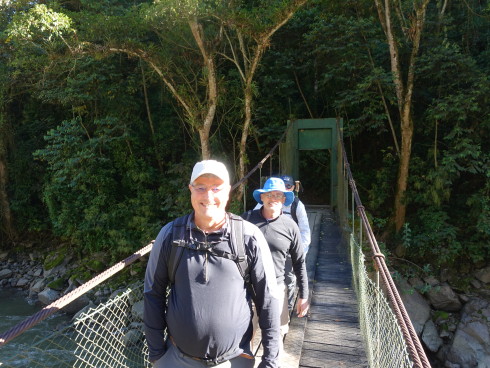
Starting the trek – we are still smiling!                                                                                                 Photo Credit Bill Riat
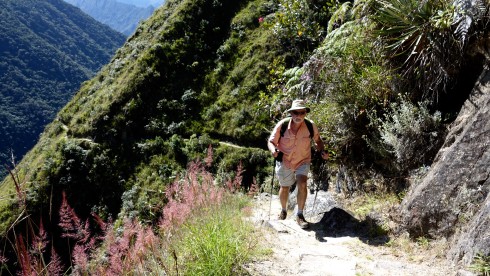
The Inca Trail to Machu Picchu (also known as Camino Inca or Camino Inka) consists of three overlapping trails: Mollepata, Classic, and One Day.  We opted for the One Day, since we have already had three days of fairly difficult hiking behind us, and time was short.
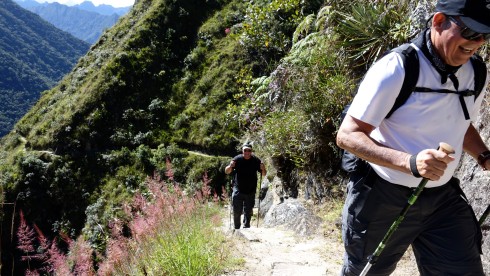
The trail soon became steep and difficult…
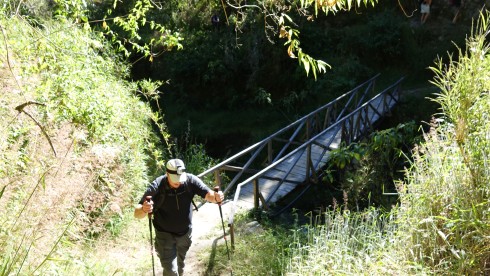
On the trail
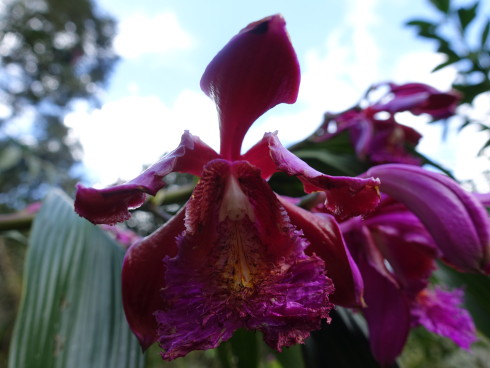
Beautiful flowers along the trail.                                                                                                      Photo Credit: Bill Riat
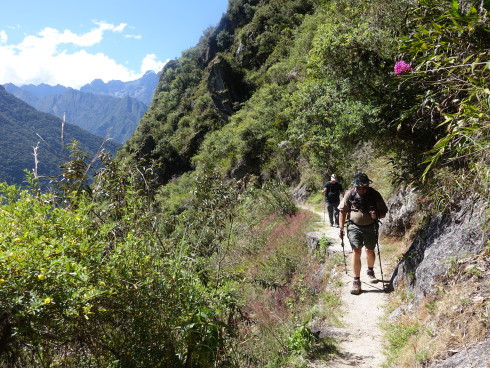
Beautiful flowers along the trail.                                                                                                       Photo Credit: Bill Riat
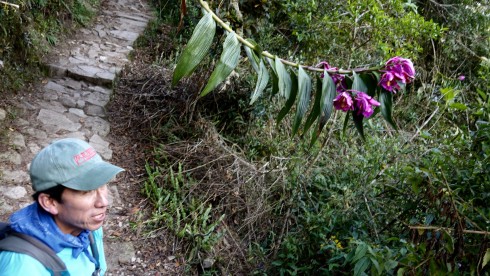
Beautiful flowers along the trail.   This orchid is endemic to the Andes.
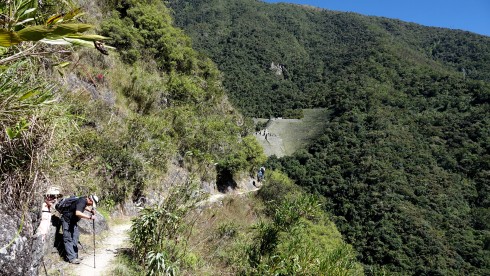
Winaywayna Fortress (Forever Young) where we would have lunch, still one hour away…
We stopped at a beautiful and refreshing waterfall for a rest, before tackling the final almost impossibly steep steps and terraces to to top of the mountain, and to the fortress Winaywayna (Forever Young)
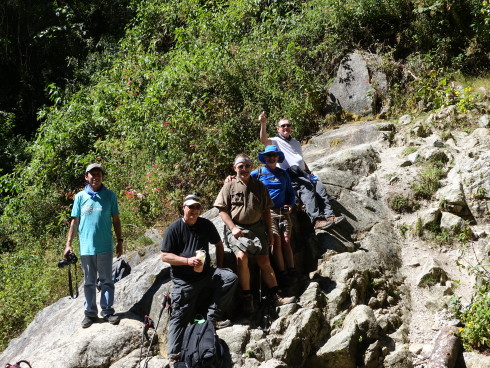
We stopped at a beautiful and refreshing waterfall for a rest
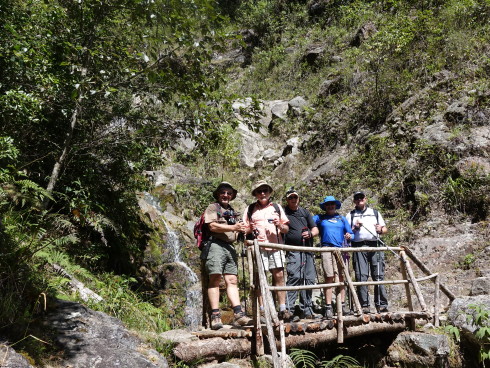
We took a short rest at a beautiful waterfall about 15 minutes from the base of Winaywayna
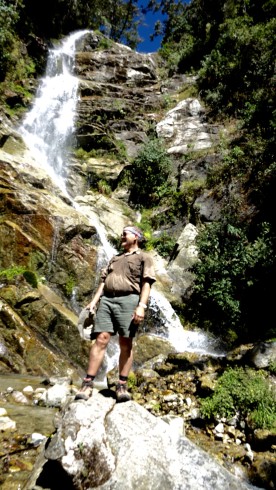
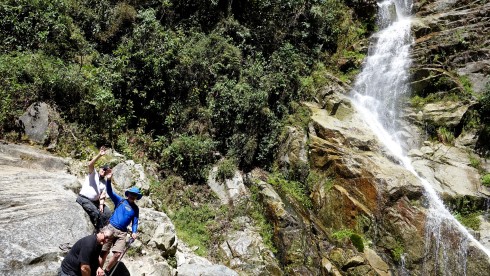
A welcome and refreshing, short break before the final push up to Winaywayna (“Forever Young”)
Soon we arrived at the stairs leading to the top of the ancient Inca ruin, huge agricultural terraces and remnants of 500-year-old buildings preserved very well. This last climb before lunch was PRETTY INTENSIVE…
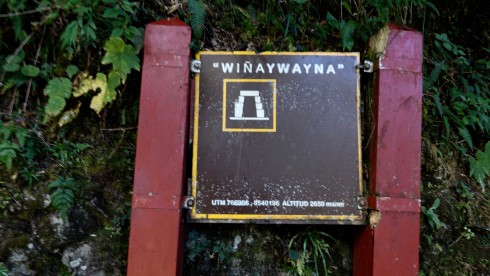
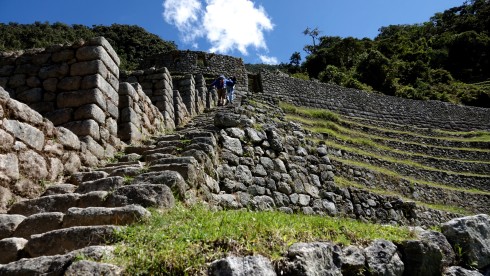
Just as one thought it was the final set of steps…
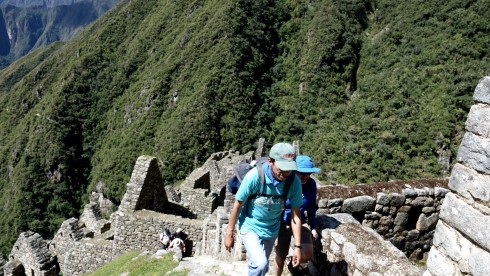
…there were more – even steeper climbing!
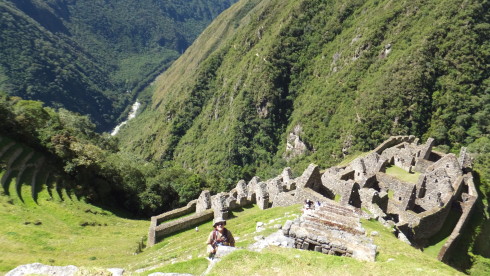
Almost there…Â Â Â Â Â Â Â Â Â Â Â Â Â Â Â Â Â Â Â Â Â Â Â Â Â Â Â Â Â Â Â Â Â Â Â Â Â Â Â Â Â Â Â Â Â Â Â Â Â Â Â Â Â Â Â Â Â Â Â Â Â Â Â Â Â Â Â Â Â Â Â Â Â Â Â Â Â Â Â Â Â Â Â Â Â Â Â Â Â Â Â Â Â Â Â Â Â Â Â Â Â Â Â Â Â Â Â Â Â Â Â Â Â Â Â Â Â Â Â Â Â Â Â Â Â Â Photo Credit: Jim Macklin
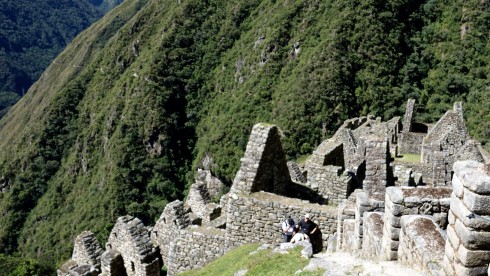
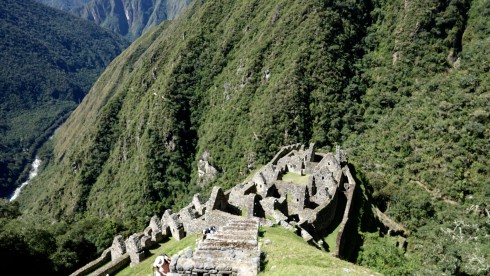
With difficulty we all made it to the top where we had a well-deserved rest and lunch.
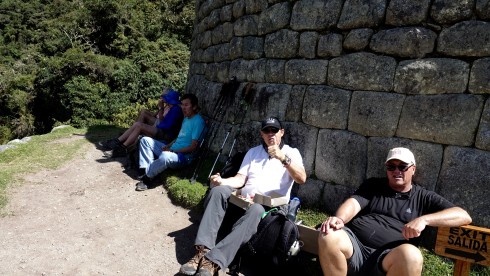
Lunch break at the top of Winaywayna
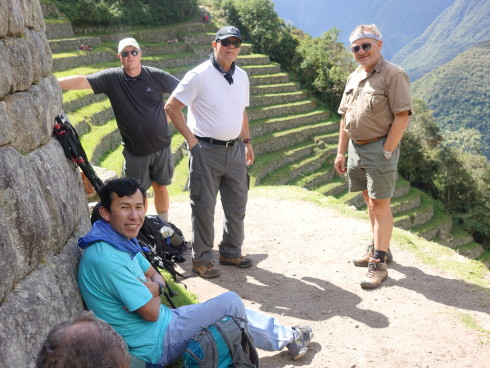
Lunch break at the top of Winaywayna
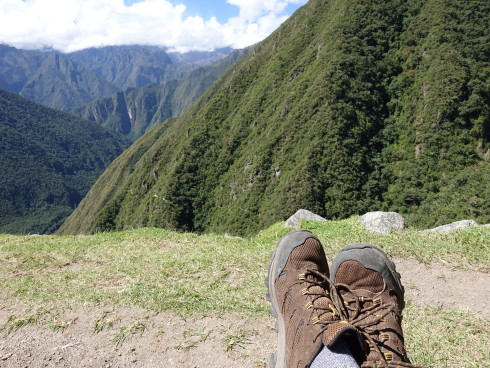
Lunch break at the top of Winaywayna.                                                                          Photo Credit and Boots: Bill Riat
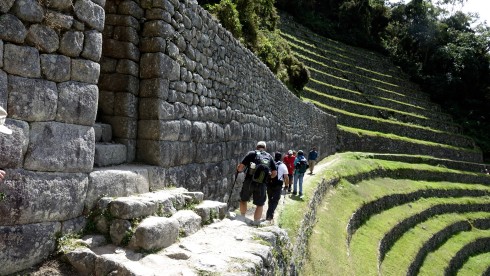
Leaving Winaywayna for the last three hours of the trek
We started out on the last three hours of the trek. The mountain seemed steeper, the steps taller and narrower.
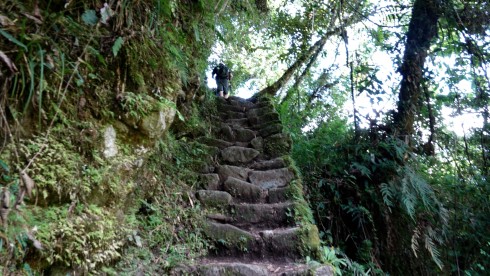
Soon after leaving Wanaywayna the steps became steeper, taller, narrower
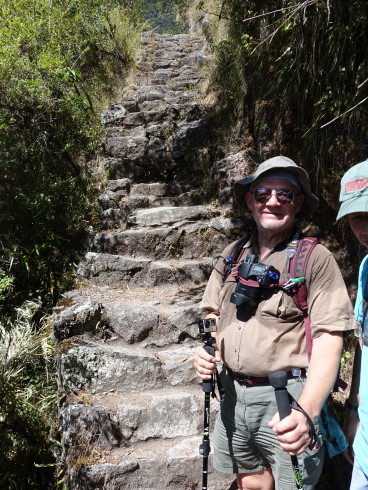
The steps became steeper, taller, and narrower.                     Photo Credit: Bill Riat
From Winaywayna the trail undulates along below the crest of the east slope of the mountain named Machu Picchu. The steep steps leading upward to Intipunku (The Sun Gate) are reached after approximately 3 Km of extremely difficult climbing, the steps knee-high and half the width of one’s foot. Reaching the crest of this ridge reveals the grandeur of the ruins of Machu Picchu, which lie below. It is one of the most important archeological constructions. Intipunku was once the main entrance to Machu Picchu, accessing it rpm the Inca Trail. This site was the main entry point from the South into Cusco, and the gate would have been protected by its military. Inti Punku is dedicated to Inti, the Sun god.
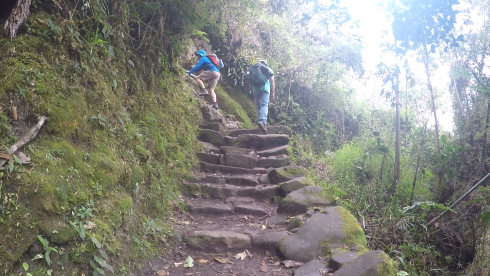
Jim starting the last climb before entering Intipunku, The Sun Gate
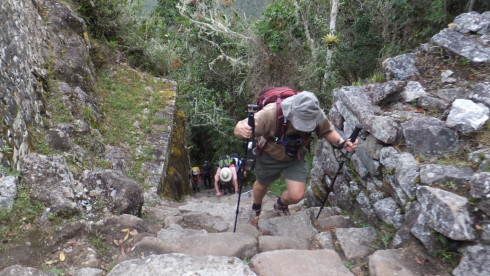
Willie following right behind him…Â Â Â Â Â Â Â Â Â Â Â Â Â Â Â Â Â Â Â Â Â Â Â Â Â Â Â Â Â Â Â Â Â Â Â Â Â Â Â Â Â Â Â Â Â Â Â Â Â Â Â Â Â Â Â Â Â Â Â Â Â Â Â Â Â Â Â Â Â Â Â Â Â Â Â Â Â Â Â Â Â Â Â Â Â Â Â Â Â Â Â Â Â Â Â Â Â Â Photo Credit: Jim Macklin

…and Bill Jim Simon and Dave finishing the virtually vertical steps.
The last 200 feet of steps carved into the steep mountainside by the ancients was almost impossible to climb…
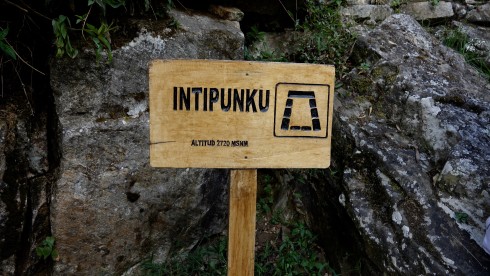
…but the emotion and the feeling of accomplishment as we walked through the Sun Gate, the full view of the wonder of Machu Picchu displayed before our very eyes more than a thousand feet and an hour hike below us, was almost too much to behold.
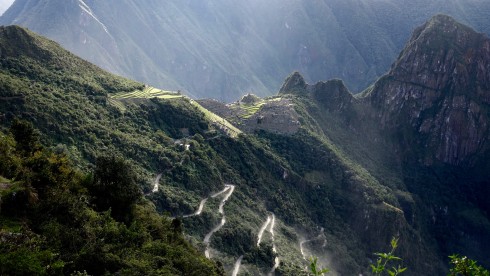
We walked through the Sun Gate, Machu Picchu far below us – still one hour away
Filled with emotion, congratulating each other on the success of our trek, we stood in awe at this terrific sight.
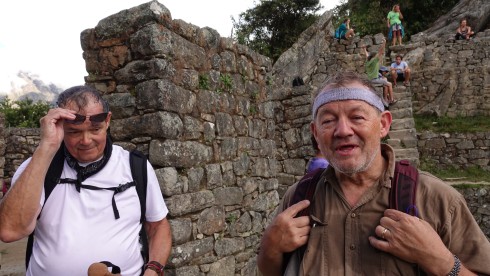
Jim and Willie – filled with emotion, congratulating each other on the success of our trek, we stood in awe at this terrific sight.
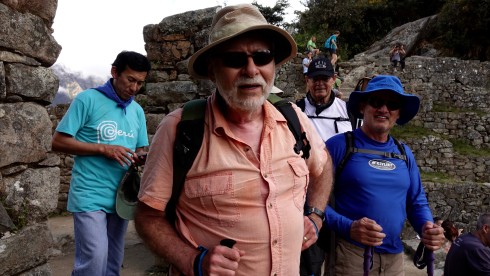
Thomas, Bill, Jim and Jim – filled with emotion, congratulating each other on the success of our trek
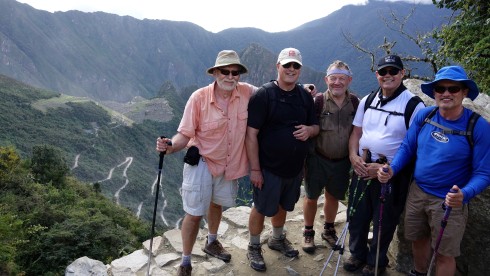
On the edge of he Sun Gate, Machu Picchu Ruins far below, with the winding dirt road another 30 minutes to Machu Picchu Pueblo below
Soon we left to finish the last 1,000 feet, one hour trek, down the mountain to Machu Picchu.
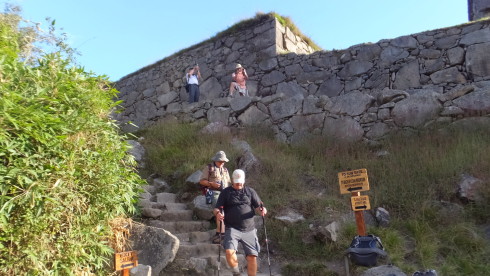
We stopped above the ancient ruins for some pictures…
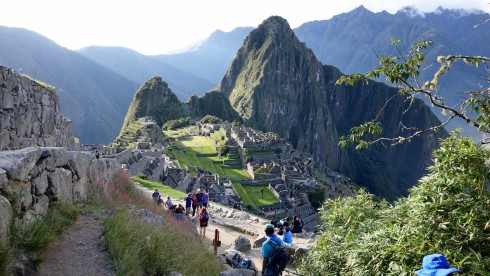
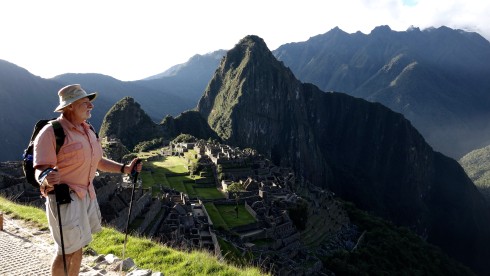 Â
 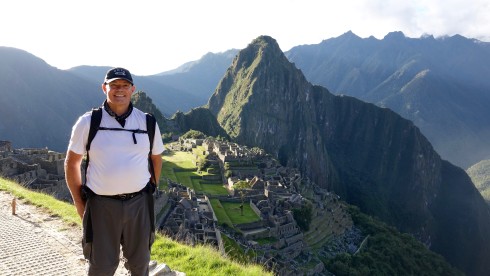
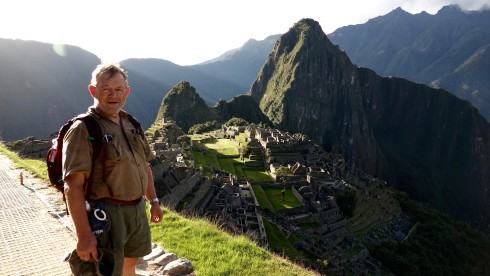
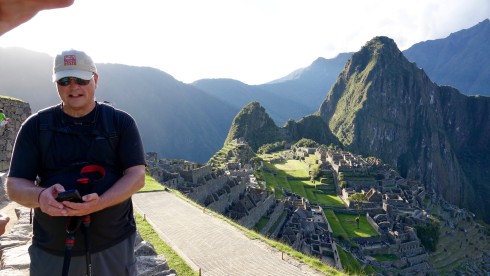
We made it to the base of the mountain by 4 PM, seven an a half hours after setting out on the Inca Trail in the morning at 8:30. We thought that was a reasonable accomplishment for a group of old guys!
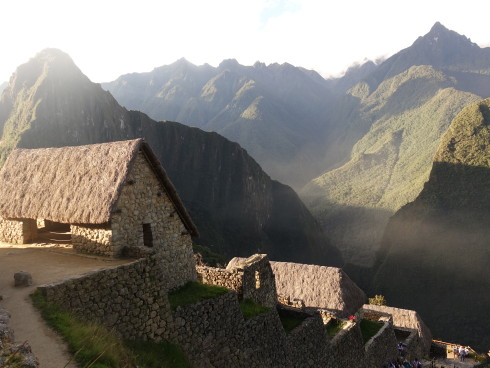
Leaving Machu Picchu to catch the bus to Machu Picchu Town.                                                   Photo Credit: Bill Riat
We boarded one of the buses taking travelers down to Machu Picchu Town on the hair raising, multiple switchback, dirt road. The buses kicked up a dust cloud like an early morning mountain fog.
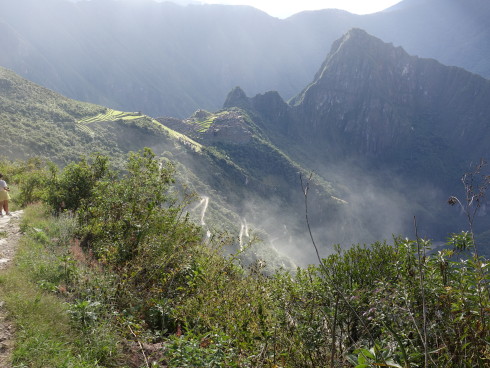
A herd of buses taking people down the mountain on the hair raising, multiple switchback dirt road kicked up a cloud of dust like an early morning mountain fog.
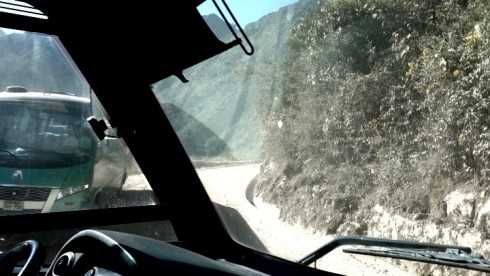
a hair raising 30-minute bus ride down the dirt road switchbacks to Pueblo Machu Picchu
We arrived in Machu Picchu town just about 5 PM, and walked through the crowded market to find our hotel and our friend Dick Alkire.
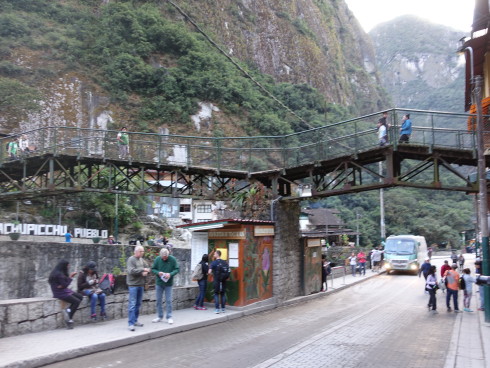
Machu Picchu Town (also called Aguas Calientes – Hot Springs)Â Â Â Â Â Â Â Â Â Â Â Â Â Â Â Â Â Â Â Â Â Â Â Â Â Â Â Â Â Â Â Â Â Â Â Â Â Â Â Â Â Â Â Â Â Â Â Â Â Â Â Â Â Â Â Photo Credit: Bill Riat
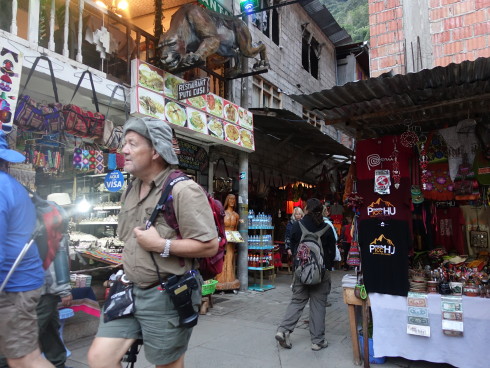
We walked through the crowded market to find our hotel                                              Photo Credit: Bill Riat
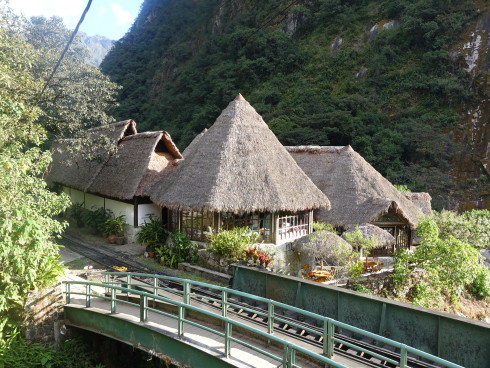
Inkaterra Machu Picchu Pueblo Hotel                                                                                            Photo Credit: Bill Riat
We were met by our friend Dick Alkire, who took the train all the way to Machu Picchu. Dick is receiving a bovine heart valve in a couple of weeks and we thought it wise for him to skip this strenuous trek!
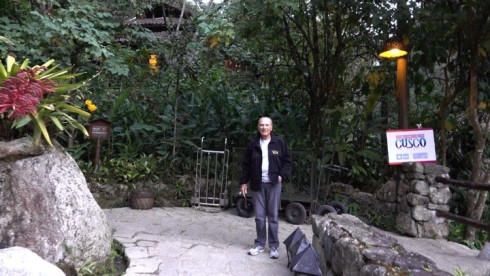
We were very happy to meet up with Dick Alkire at the entrance to the hotel
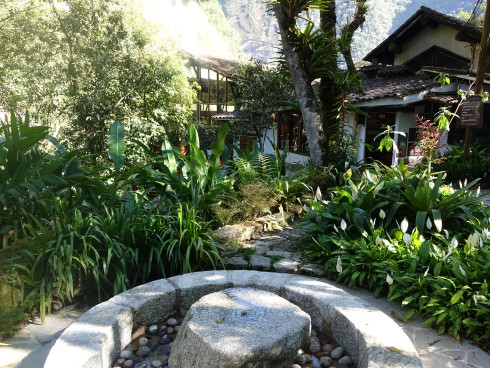
Inkaterra Machu Picchu Pueblo Hotel                                                                                         Photo Credit: Bill Riat
We celebrated with the local beer, Cussqueña, and after a good shower and a hearty dinner we went straight to bed, exhausted.
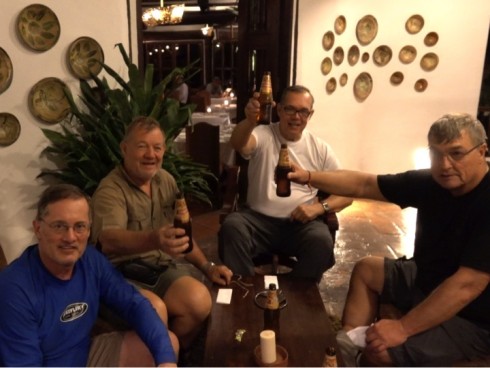
Well-desreved Cusqueña cerveja – Bill was already in the shower…                                                             Photo Credit: Dick Alkire
Tomorrow morning I leave early to climb to the summit of Montana Machu Picchu (Machu Picchu Mountain), and then will join the group at about mid-day to explore the famous Machu Picchu ruins. I learned that they only allow 400 climbers a day on Montana Machu Picchu, so i was really impressed when our guide, Thomas, showed up before dinner with my permit to climb the mountain tomorrow morning at 9 AM.
>>>>>>>>>>>>>>>>>>>>>>>>>>>>>>>>>>>>>>>>>>>>>>>>
Saturday, May 21: Day 7
Climbing Montana Machu Picchu
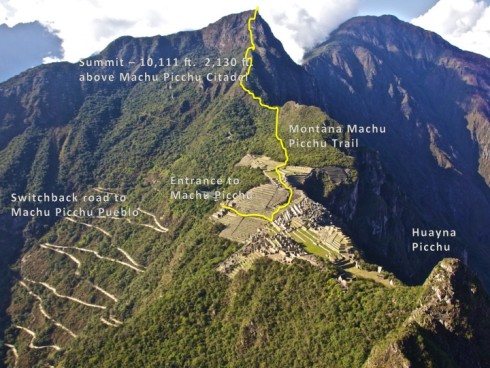
![]() Â Climbing Montana Machu Picchu
 Climbing Montana Machu Picchu
I heard that Machu Picchu Mountain is the most spectacular yet one of the most overlooked optional treks available at Machu Picchu, so I decided I really wanted to climb this mountain in spite of the strenuous trek we had yesterday.
Located to the south-west of Machu Picchu citadel and towering 3,050 meters (10,111 feet) above sea level, the mountain trek offers unparalleled views of the famous Inca sanctuary and panoramic vistas of the surrounding mountain scenery.
At its summit Inca priests once performed rituals on special dates as well as liturgical greetings to the Salkantay Apu. The snow-capped peak, Apu Salkantay, is one of several sacred mountains that ring Machu Picchu. For centuries, the Incas have honored each mountain — or Apu — as a unique, divine consciousness. Little did I know what a profound experience it would be for me to stand at the summit of Montana Machu Picchu and see Salkantay Apu.
I was up at 6:30 AM, had a quick breakfast, and made it down to the bus stop in Machu Picchu Pueblo.
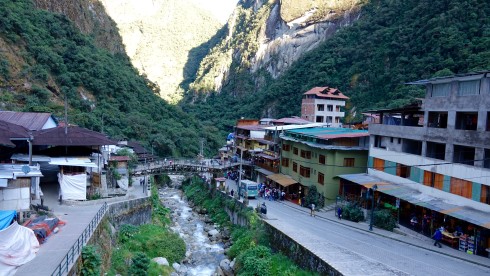
After a quick breakfast, I made it down to the bus stop in Machu Picchu Pueblo.
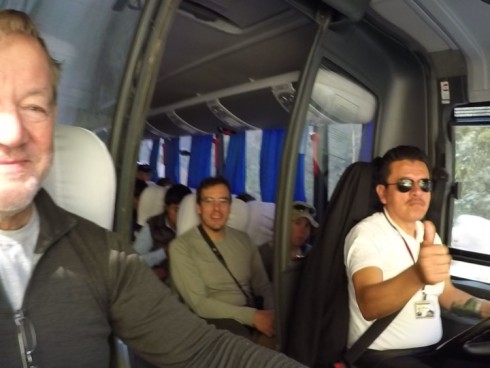
A hair raising ride up the mountain to the entrance of Macchu Picchu
After a hair raising ride up the mountain to the entrance of Macchu Picchu, I walked through the entrance to this holy, ancient Inca citadel, and made it to the intersection of the Sun Gate and the Machu Picchu Mountain Trail.
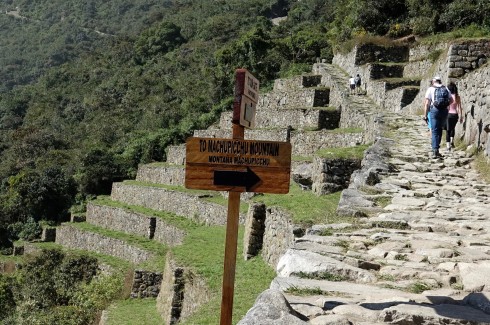
Montana Machu Picchu trail head
I signed in at the checkpoint at the base of Montana Machu Picchu.
I arrived at the check point at 9 AM where I had to check in and show my passport and permit. The nice lady explained that I have six hours to complete the climb, but “If you are not at the summit at 12 PM you must turn around and come back down.” The trek is supposed to take three hours or more, depending on one’s fitness. We had arranged for me to meet the rest of the group at 12 PM, so I had exactly three hours to make this 2,300 ft. climb, and return to Machu Picchu by Noon.
The going was fairly gentle for the first five minutes, and then became immediately steep. After the check-in hut the trail follows a fairly even ascent of about 30 – 35 degrees for about 1 hour.
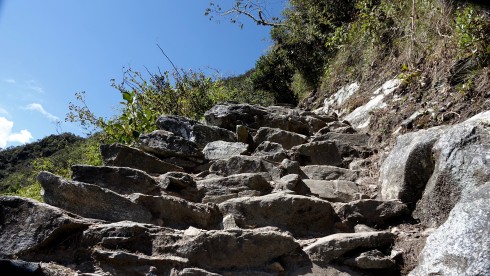
The going was fairly gentle for the first five minutes, and then became immediately steep
I made it to the halfway point in 55 minutes, so I was pleased with my progress. I took a two minute rest and drank some water, while admiring the amazing views of the valley below from this vantage point.
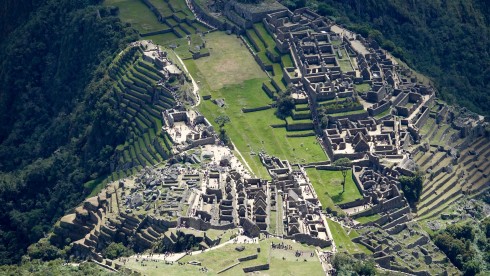
A spectacular view from this vantage point, about 1,000 feet up
Exactly at 10 AM I set of for the last half of the climb. Gradually and steadily gaining altitude, the views of Machu Picchu and the surrounding mountains become ever-more impressive.  The trail became steeper, the “steps” taller and narrower.
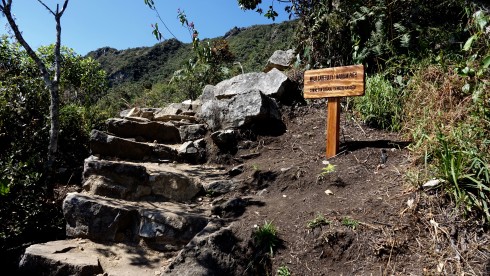
The trail became steeper, the “steps” taller and narrower.
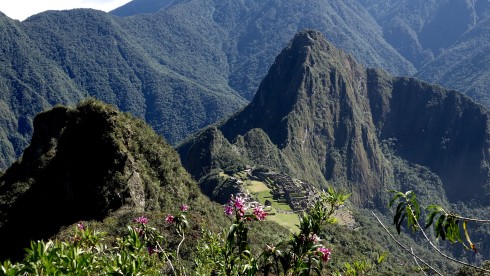
views of Machu Picchu and the surrounding mountains become ever-more impressive.
By now I was sweating profusely, and wondering if I could make the two-hour deadline to the top. Trekkers on their way down would quietly encourage one with, “almost there,” “it is worth it,” and “only 20 minutes more.” Total strangers in a common quest, supporting one another.
I was moving as fast as I could at the 10,000 ft. altitude, worrying if I would meet my deadline of 11 AM to the summit. Steps as high as my knee and as narrow as the width of my foot made the task no easier. Finally, sweating and exhausted, I saw the summit.
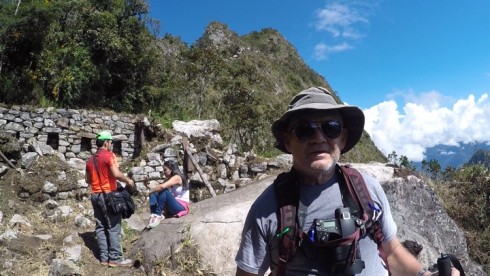
About 20 minutes to go. The trail winds along the side of the mountain, the summit directly behind me.
Winding on for another 15 minutes or so, the trail passed through a stone gateway before following the narrow mountain ridge to the summit.
At this point, as I was approaching the final steep steps to the summit, exhausted and panting from the exertion, an amazing thing happened.
My wife Katie’s mother, Grace Tharp was one of the most wonderful people in my life, and I felt as close to her as I did to my own mother. Grace Tharp was an avid gardener, and she loved butterflies. She said, “Happiness is like a butterfly. If you chase it, you may never find it. But if you just sit still for a few moments it may light upon you.” Grace died about 14 months ago.
As I approached the summit, suddenly, out of nowhere and unusual for this altitude, a swarm of butterflies appeared in front of me. “Hello, Mother,” I said, almost in tears, as I started feeling the familiar sensation of relief, gratification, and euphoria I have experienced at the summit of Kilimanjaro in Tanzania and both times I reached Everest Base Camp in the Himalaya.
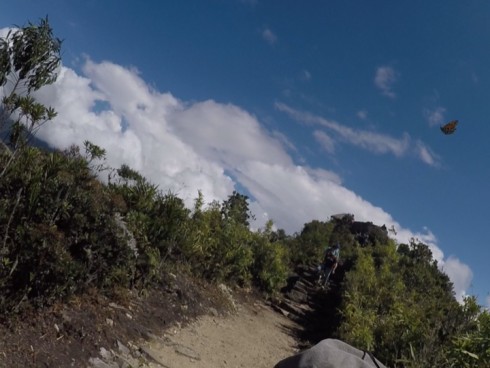
A butterfly taking off in flight after briefly landing on my nose to feast on the minerals of my sweaty skin
I sat down for a moment to collect myself as the butterflies swirled around my head, one of them briefly landing on my nose to feast on the minerals of my sweaty skin before taking off in flight.
Suddenly they were gone and I heard myself say, “I guess you were not going to stick around too long, but thank you for the sign, Mother!”
I picked myself up off my rock perch and started up the final couple hundred feet up to the summit, the steps steep and narrow.
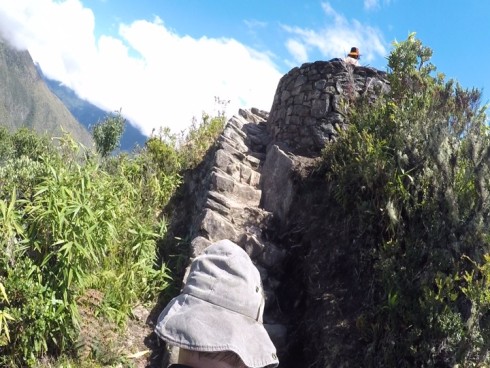
I started up the final couple hundred feet up to the summit,
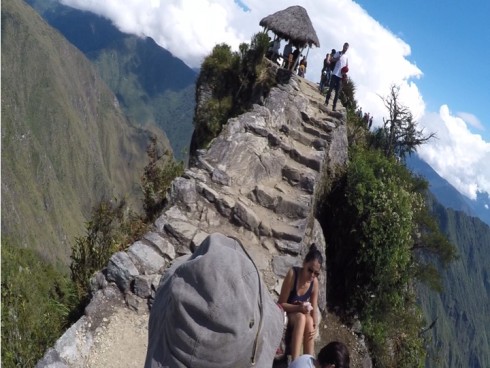
The drop-offs at this point are vertical for a thousand feet on both sides, the trail narrow; one pretty much climbs on the razor edge of the mountain leading to the summit.
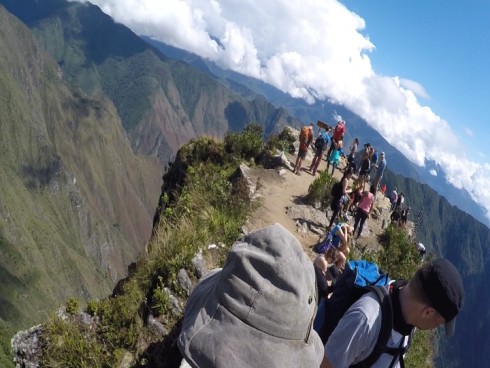
Final approach to the summit of Montana Machu Picchu
It was exactly 11 AM, the allocated time for my climb achieved. A worthy goal.
For the second time in as many days the view took my breath away. I walked to the edge of the very narrow summit, a two thousand foot drop right at my feet.
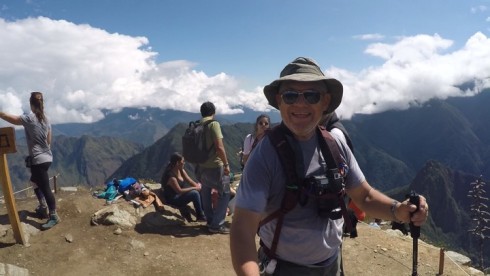
I walked to the edge of the very narrow summit, a two thousand foot drop right at my feet.
In the distance I could see Salkantay Apu, the clear morning sunlight reflecting off the now-capped peak.
3,000 ft. below me lay the Urubamba River valley, the gorge in the mountains carved over millions of years.
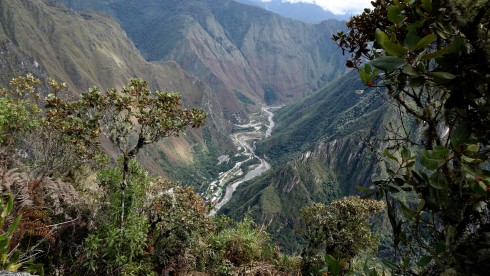
3,000 ft. below me lay the Urubamba River valley…
Directly below me, more than 2,200 ft. down, I saw the most spectacular view of the ancient citadel of Machu Picchu, the people exploring down there as small as ants. Behind Machu Picchu the famous mountain Huanya Picchu.
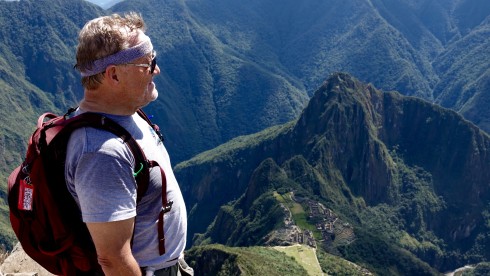
Directly below me, more than 2,200 ft. down, I saw the most spectacular view of the ancient citadel of Machu Picchu!
I panted for a while, composing myself, while enjoying the energy and the spirit flowing into me from the mountains surrounding Machu Picchu. In the words on John Muir, the care of the world fell off me like the leaves from trees in the autumn wind.
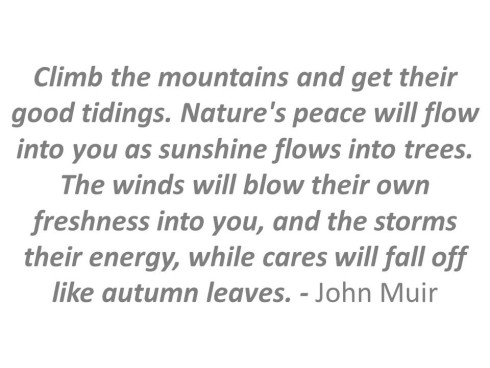
I spent about 20 minutes at the summit, lost in the euphoria of the view and sence of spiritual and physical accomplishment. With a start I realized that it was now 11:20, and I needed to meet my friends at the entrance at Noon.
I tore myself away from this scene, and started the trek down the mountain.
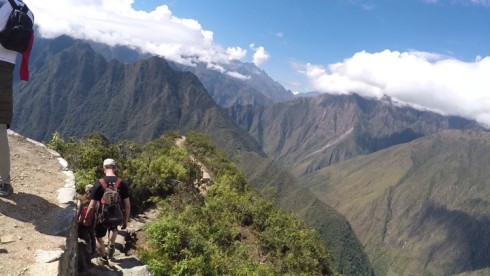
I tore myself away from this scene, and started the trek down the mountain
I have always liked downhill more than uphill – I love using my trekking poles almost as crutches, and enjoy the challenge of finding secure footholds at high speed. I literally “ran” down the mountain, finding the small steps, stepping on an uneven rock, avaoiding other slower trekkers. Nobody passed me on the downhill.
I made it down to check-in hut exactly at 12 PM, less than 45 minutes. I finally met up with my friends at the Sacred Rock, and joined theme, continuing the exploration of Machu Picchu which they had started about an hour earlier.
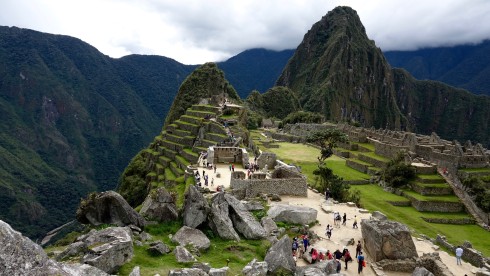
Arriving back at Machu Picchu at 12 PM, I joined my friends in exploring the site
Helpful Info
From Peru Guide website
Time needed: 2h30 minutes accent, descent – 1h15, plus 30 minutes at the summit. 4 1/2 to 5 hours
Altitude of summit:Â 3,082 meters (10,111 feet) above sea level.
Height to climb from Machu Picchu: 652 meters (2,139 feet).
Terrain: Inca Trail stone path steps and in places grass/dirt.
Recommended footwear: Â Training shoes, light weight walking boots.
Entrance time: 7 – 11am.
Trail head: in the south-west of Machu Picchu citadel.
![]() Â Climbing Montana Machu Picchu
 Climbing Montana Machu Picchu
++++++++++++++++++++++++++++++++++++++++++++++++
Exploring Machu Picchu
While I was making my way down Miontana maccu Picchu, our group started the Machu Picchu exploring tour.
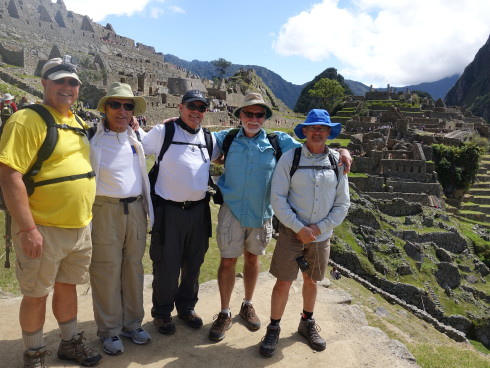
Dave, Dick, Jim Simon, Bill, and Jim Macklin at the start of the Machu Picchu tour               Photo by our guide, Thomas
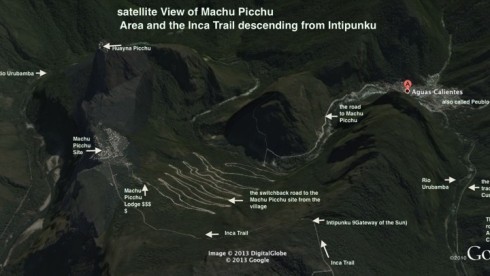
Satellite view of the Machu Picchu site Credit:Â Â Â Â Â Â Â Â Â Â Â Â Â Â Â Â Â Â Â Â Â Â Â Â Â Â Â Â Â Â Â Â Â Â Â Â Â Â Â Â Â Â Â Â Â Â Â Â Â Â Â Â Â Â Â Â Â Â Â Â Â Â Â Â Â Â Â Â Â Â Â Â Â Â Â Â Â Â Â Â Â Â Â Â Â Â Â Â Â Â Â Â Â Â Google Earth
A Guide to Machu Picchu
Credit: Peru Guide website
Lost to the outside world for over 500 years and never found by the Spanish conquistadores, Machu Picchu is the finest example of an Inca citadel anywhere in Peru. Perched on a secluded mountain ridge on the edge of Peru’s Amazon Jungle, its many agricultural terraces and expertly crafted buildings and temples seamlessly merge into the mountainside.
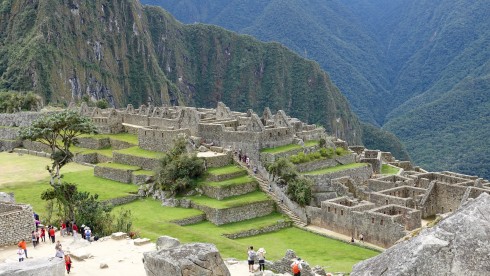
Photo Credit: Dick Alkire
A UNESCO World Heritage Site, a New Wonder of the World and simply one of the most beautiful places on the planet, Machu Picchu offers the best insight into a mysterious lost civilization and embodies everything about the mighty Inca Empire.
Machu Picchu: A Short History
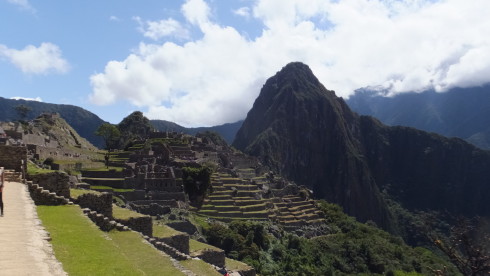
The Urban Sector                                                                                                                       Photo Credit: Jim Macklin
The Origins
Built during the reign of Inca Pachacutec (1438 – 1471), Machu Picchu took some 30 years to construct. Due to limited historical information the true and original name of this epic Inca citadel is unknown. The name Machupicchu (written in English as Machu Picchu) was given to the citadel by Hiram Bingham after its scientific discovery in 1911. The name, a Quechua word, derives from the mountain that lies to the south-west of the citadel, and today it is widely accepted that that the name Machu Picchu translates as “Old Mountain.â€
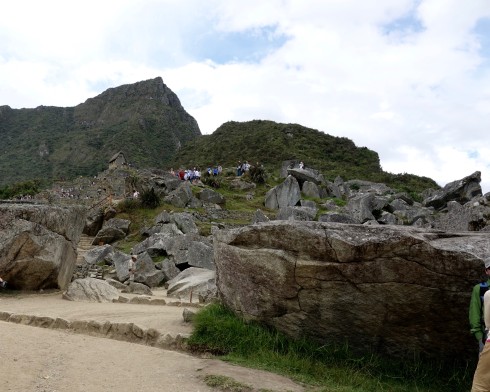
The view from below the Rock Quarry, Montana Machupicchu towering over the citadel
The Citadel
Machu Picchu covers a vast area of approximately 22.3 acres, and is constructed on a mountain ridge high above the Urubamba Valley.  Machu Picchu is split into two main sectors: the Agricultural Sector in the south and the Urban Sector in the north, of which both are roughly equal in size.
Granite stone was the main building material used in the construction of Machu Picchu, which was obtained from onsite quarries and others within close proximity. The Agricultural Sector is largely made up of row after row of stepped terraces and store houses, whilst the Urban Sector is made up of streets, corrals, kanchas, storehouses, lodgings and impressive temples. The finest Inca construction techniques were reserved for the Royal Quarter; the best examples are found at the Sacred Plaza, the Temple of the Sun and the Temple of the Moon.
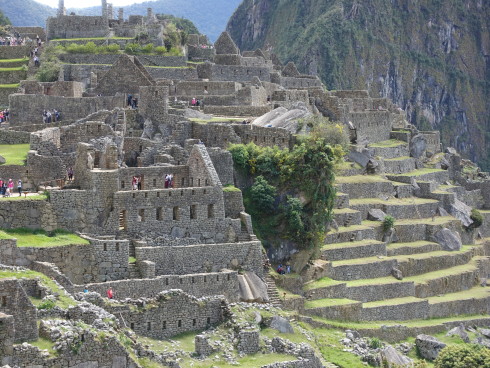
The Urban Sector                                                                                                                                  Photo Credi:; Bill Riat
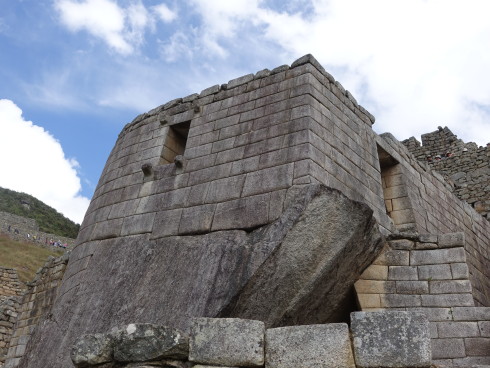
The Temple of the Sun                                                                                                        Photo Credit: Bill Riat
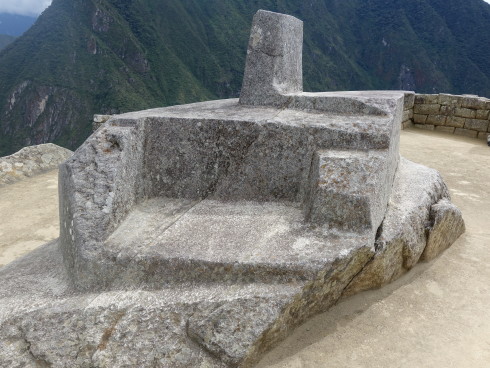
The Itiwatane (Solar Clock) in the Sun Temple of the Sun                                                       Photo Credit: Bill Riat
The Residents
It’s not known precisely how many people lived at Machu Picchu, but historians estimate that the population was between 1000 – 1200 people.
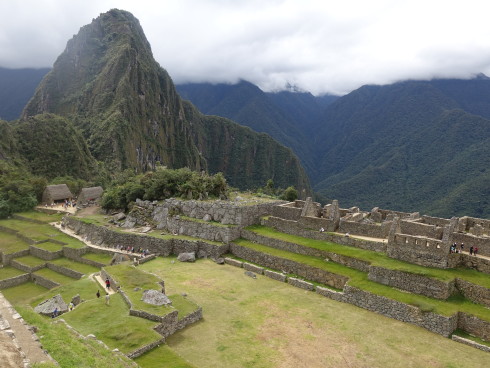
During archaeological excavations in 1912 a total of 107 burial caves situated around the Inca city were found. Archaeologists under the direction of Dr. George Eaton recorded 164 human skeletons, of which a disproportionately high number were adult females. In recent years medical experts claim that the methods used to determine sex and age of the skeletons during the original expedition where not highly sophisticated, leading to debate about the actual findings.
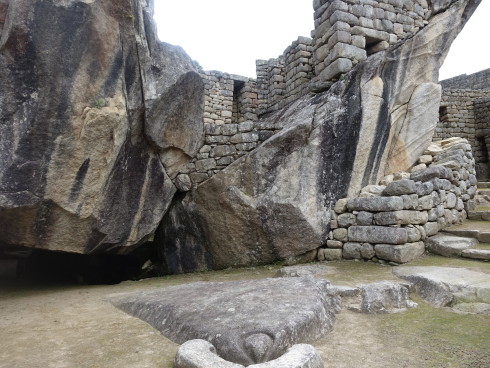
The Temple of the Condor
The Spanish Conquest

The Rock Quarry
Between 1537 – 1545, as the small Spanish army and its allies started to gain ground over the Inca Empire, Manco Inca abandoned Machu Picchu, fleeing to safer retreats. The residents took with them their most valuable belongings and destroyed Inca trails connecting Machu Picchu with the rest of the empire.  Machu Picchu was never found by the Spanish, and subsequently was left untouched, lost to the dense Amazon Jungle for the next 5 centuries.
The Re-discovery
On the morning of July 24, 1911, Hiram Bingham the young Yale University lecturer and explorer s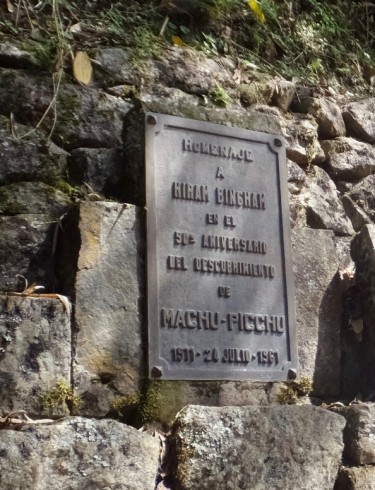 tumbled upon the Inca City of Machu Picchu. Led by a local pheasant famer Melchor Arteaga and a young boy called Pablito, Hiram Bingham was taken to the sprawling Inca citadel, hidden below a blanket of dense Amazon Jungle. Incredibly Machu Picchu was initially overlooked by Bingham, spending only a short time at the citadel before continuing his expedition to find the last known stronghold of the Incas – the city of Vilcabamba. Although Hiram Bingham was the first to really bring Machu Picchu to the world’s attention, evidence shows that other explorers had arrived at Machu Picchu many years before. In 1874 the German explorer Herman Göhring registered the citadel on his expedition map. Later, in 1901 Agustin Lizarraga left his name engraved on a wall of the three Windowed Temple, which was recorded as part of Hiram Bingham’s findings, but later omitted from his memoirs.
tumbled upon the Inca City of Machu Picchu. Led by a local pheasant famer Melchor Arteaga and a young boy called Pablito, Hiram Bingham was taken to the sprawling Inca citadel, hidden below a blanket of dense Amazon Jungle. Incredibly Machu Picchu was initially overlooked by Bingham, spending only a short time at the citadel before continuing his expedition to find the last known stronghold of the Incas – the city of Vilcabamba. Although Hiram Bingham was the first to really bring Machu Picchu to the world’s attention, evidence shows that other explorers had arrived at Machu Picchu many years before. In 1874 the German explorer Herman Göhring registered the citadel on his expedition map. Later, in 1901 Agustin Lizarraga left his name engraved on a wall of the three Windowed Temple, which was recorded as part of Hiram Bingham’s findings, but later omitted from his memoirs.
1912 Archaeological Expedition
In 1912, The National Geographic and Yale University led my Hiram Hingham organised an excavation of Machu Picchu. With support from the Peruvian Government and help from local hired labour, Bingham set about to unveil the hidden secrets of the Inca city.  Starting in strategic locations around the citadel, they opened tombs, recovered important structures from the heavy jungle growth, made archaeological digs and photographed the area.
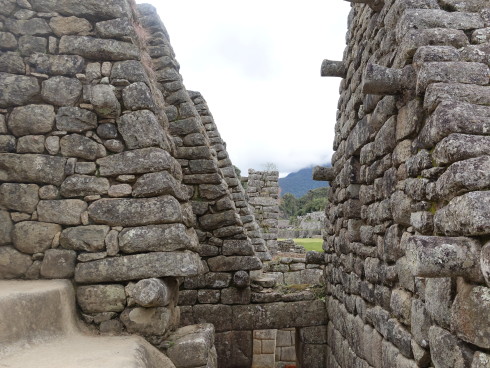
Although the excavations were extensive, very little of great importance was found. Thousands of small articles were recovered including pieces of pots, plates, jugs cups and vases. Lithic materials found included hundreds of hammer stones, mortars, grinders and polishing stones. Due to the degradation from the humid climate little clothing or fabrics where recovered. No hierarchical mummies were discovered, with only tomb number 26 located on the trail to Inti Punku yielding significant importance. Many of the articles recovered from Machu Picchu were later (rightly or wrongly) shipped to Yale University in the USA, where further scientific examinations were carried out. In recent years, after a high profile campaign by the Peruvian government, most of the items have now been returned to Peru and are on display at La Casa Concha Museum in Cusco’s historic centre.
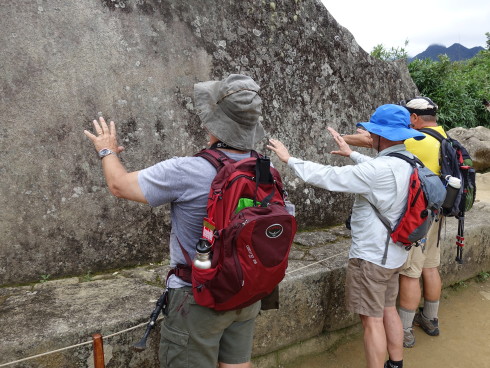
Getting positive energy from The Sacred Rock                                       Photo Credit: Dick Alkire
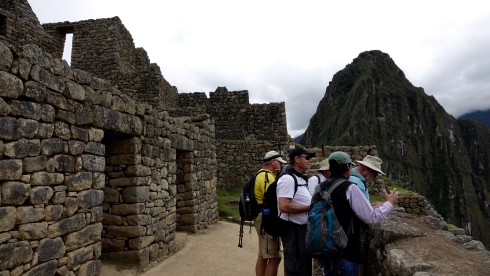
The Astronomical Mirrors Room
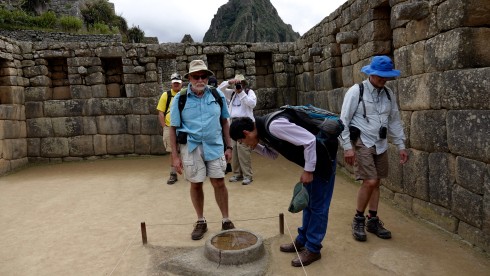
The Astronomical Mirror was used to study the night sky
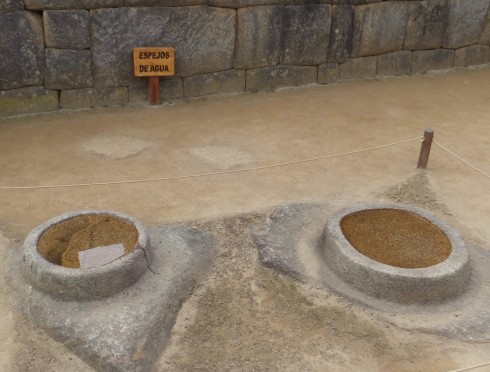
The Astronomical Mirrors were used to study the night sky
Machu Picchu Today
Today, this epic Inca citadel is one of South America’s (if not the world’s) greatest archaeological sites. In 1981, Machu Picchu was declared a Peruvian Historical Sanctuary and later in 1983, it became a UNESCO World Heritage Site.
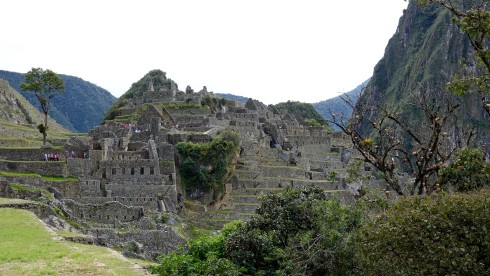
Official tourism figures for 2015 showed that Machu Picchu received over 700,000 international and national visitors, peaking during the months of June and July. Currently the Peruvian government has set a limit of 2,500 entrance tickets per day, but international interest is increasing at a rapid rate, with tourism figures growing by approximately 10% year on year. Worries over the environmental impact from over exploitation by tourism is a growing challenge for the future of Machu Picchu and indeed tourism in Peru.
Source: The Only Peru Guide
+++++++++++++++++++++++++++++++++++++++++++
We had a late lunch, and stood in a huge line to catch the bus back to Machu Picchu Pueblo for our last night at the Inketerra Machu Picchu Pueblo hotel.
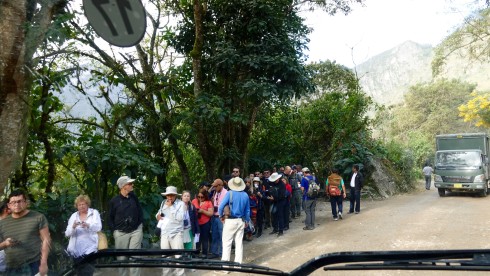
>>>>>>>>>>>>>>>>>>>>>>>>>>>>>>>>>>>>>>>>>>>>>>>>
Sunday, May 22: Day 8
Travel Day to Cusco
![]() Return to Cusco and Corpus Christi Festival Parade
Return to Cusco and Corpus Christi Festival Parade
We caught the 8 AM train back to Ollantaytambo. The Inca Rail train was very comfortable. Their website invites one to ” EXPERIENCE THE MAGIC OF TRAIN TRAVEL: Treat yourself to a journey in harmony with mystical Machu Picchu. Ornately decorated carriages with comfortable seats designed for your enjoyment of the landscape through panoramic windows en route to and from the age-old Inca citadel.  The train offers “comfortable seats with tables in front to share the journey with friends or family, ample windows to admire the stunning countryside, relaxing background music, and an appetizing selection of cold and hot drinks, prepared using fresh fruit juice and Andean herbs.” – Inca Rail website.
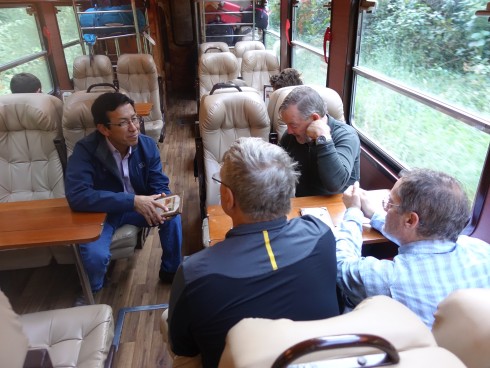
The Inca Rail train was very comfortable.                                                                                        Photo Credit: Bill Riat
After about two hours of traveling through stunning scenery we arrived back at Ollantaytambo where we were met by our driver, Wasi, for the two-hour trip back to Cusco.
About 15 kilometers from Cusco, the road was suddenly blocked by officials. Our van happened to be the first to be stopped. This was fortunate, since it gave us a VIP-ringside seat to the start of the Corpus Christi Festival parade.
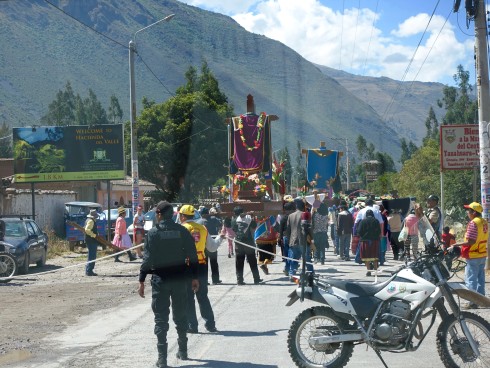
We got out of the van, and in seconds we were immersed in the parade and festivals as thundreds, no, more like thousands of costumed dancers, passed by, with many well-decorated people carrying floats and large images of the 15 patron saints of Peru down the main highway. They were on their way to the major celebrations in Cusco, singing, dancing, and leading and following band after band as they pass by.
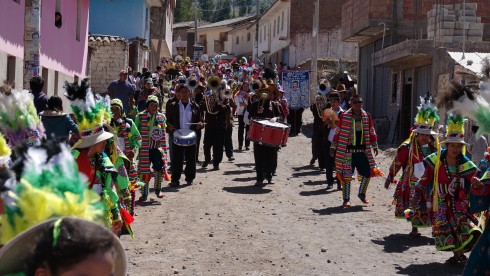
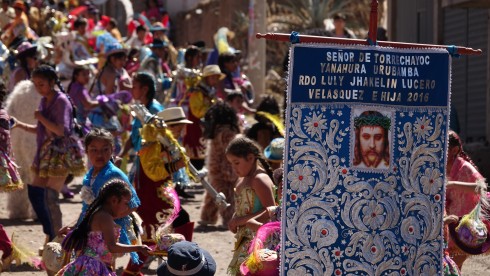
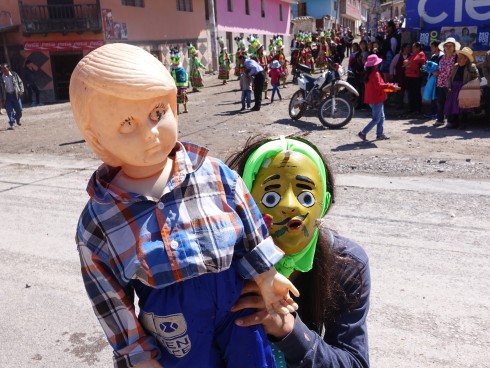
Photo Credit: Bill Riat
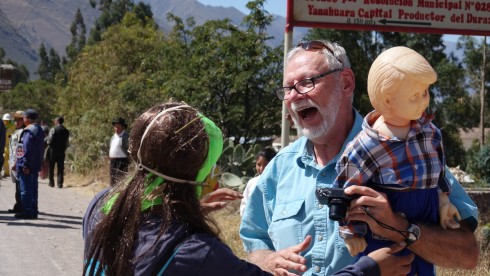
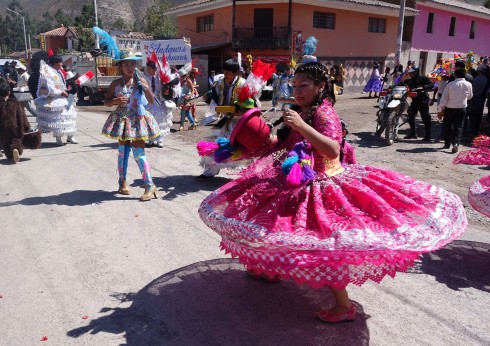
What a wonderful bonus to be so fortuitously entertained by the wonderful, friendly Peruvians on their special festival day!
We made it to Cusco mid-day, had a wonderful lunch, and took the rest of the day easy.
Tomorrow we fly to Puerto Muldonado for a few days in the Amazon Rain Forrest.
>>>>>>>>>>>>>>>>>>>>>>>>>>>>>>>>>>>>>>>>>>>>>>>>>>>>

